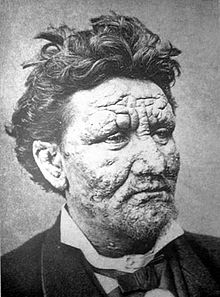Émile Marchoux
Émile Marchoux (born March 14, 1862 in Saint-Amant-de-Boixe , † August 19, 1943 in Paris ) was a French tropical medicine .
Life
Marchoux studied medicine in Paris and graduated in 1887 with a doctoral thesis on typhoid epidemics among marines in Lorient . He then joined the corps of marine doctors and, when it was founded in 1890, switched to the colonial medical service ( Corps de Santé colonial ). First he was transferred to Dahomey , then to Cochinchina , where he was responsible for vaccinating the local population against smallpox . Marchoux returned from Indochina in 1893, applied to the Pasteur Institute and was hired personally by Louis Pasteur . He was assigned to the laboratory of Émile Roux , where he succeeded in producing a serum against anthrax . In 1896 he was sent to Africa, where he founded the first microbiological laboratory in Africa in Saint-Louis, Senegal .
At that time there was a tendency in colonial medicine to attribute all febrile diseases to malaria . Marchoux found that there were numerous other causes in Africa: yellow fever , amoebic dysentery, and various tick- borne diseases. He described the life cycle of the most common malaria pathogen in Senegal, Plasmodium falciparum , which also caused the most severe form of malaria. Its publication in 1897 in the Annales de l'Institut Pasteur was the first microscopic study of the malaria pathogen that originated in the tropics. Further research examined the role of pneumococci in pneumonia in the African context. Marchoux was also able to detect meningococci for the first time in Africa, which are particularly common in meningitis south of the Sahara .
In 1900 a yellow fever epidemic broke out in Senegal, and at the same time a group of American doctors in Havana discovered the carrier of the disease, the yellow fever mosquito (actually a rediscovery, as the work of Carlos Finlay had been forgotten). Marchoux was then sent by the Colonial Ministry to Havana and Brazil as part of a French medical mission. Within four years, the scientists were able to show that the yellow fever pathogen was a "filterable virus", that is, it could be filtered through bacteria-proof filters. The pathogen could be detected in the blood during the first four days of the disease and its reproduction in the mosquitoes was dependent on the temperature. This research made it possible to understand why those living in cooler areas at intermediate altitudes suffered less from yellow fever. The French were also involved in the successful campaign to rid Rio de Janeiro of yellow fever; Marchoux was made an honorary citizen of the city.
In 1905 Marchoux returned from Brazil and left the colonial medical service to return to full work at the Pasteur Institute. He was first head of the laboratory, then head of department in Metschnikow's laboratory (Nobel Prize 1908), then at Laveran , when he received the Nobel Prize in 1907. During this time, Marchoux initially dealt with a poultry disease that raged in Brazil and for which he brought research material with him from his trip. He was able to detect a spirochete as the pathogen , which was transmitted by ticks - the first example of a blood disease transmitted in this way.
However, his preferred field of research became leprosy . Since it was not possible to cultivate the pathogen , Marchoux established an animal model with the rat. His studies made it clear that leprosy was less contagious than tuberculosis , so that the usual secretion of leprosy sufferers could not be medically justified. Marchoux was able to found an institute for research into leprosy in Bamako (today Mali ), which was named after him after his death (today: Center National d'Appui à la Lutte contre la Maladie, CNAM). As a leprosy expert, Marchoux also advised the League of Nations and was eventually appointed President of the International Leprosy Society.
In 1925 Marchoux was elected to the Academy of Medicine. Since it was founded, he was a member of the Academy of Colonial Sciences, which he also headed from 1931–32. He was a Grand Officer in the Legion of Honor .
literature
- Hommes et destins: dictionnaire biographique d'outre-mer . Vol. 9. Ed. Académie des sciences d'outre-mer. Académie des sciences d'outre-mer, Paris 1975–1989.
Web links
| personal data | |
|---|---|
| SURNAME | Marchoux, Émile |
| ALTERNATIVE NAMES | Marchoux, François Émile Gabriel |
| BRIEF DESCRIPTION | French tropical medicine |
| DATE OF BIRTH | March 14, 1862 |
| PLACE OF BIRTH | Saint-Amant-de-Boixe |
| DATE OF DEATH | August 19, 1943 |
| Place of death | Paris |

